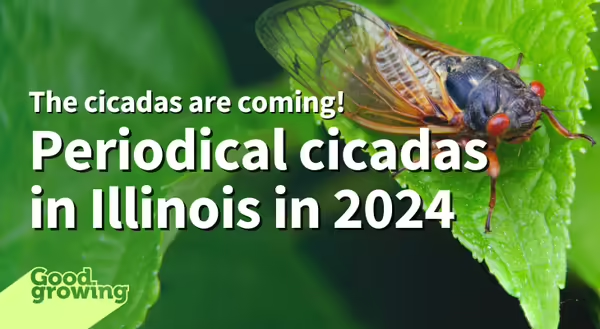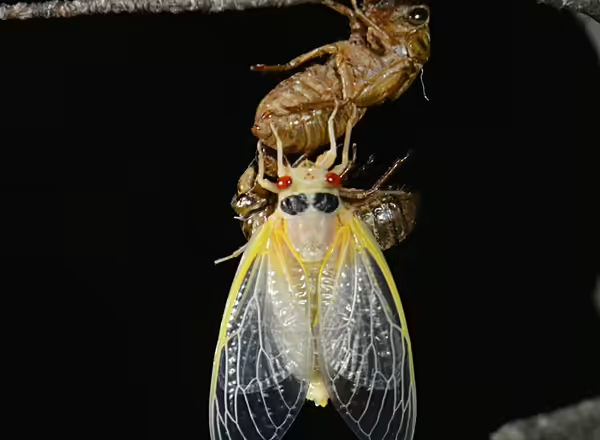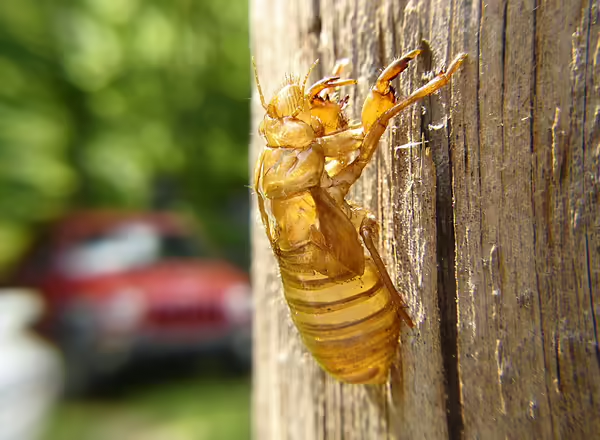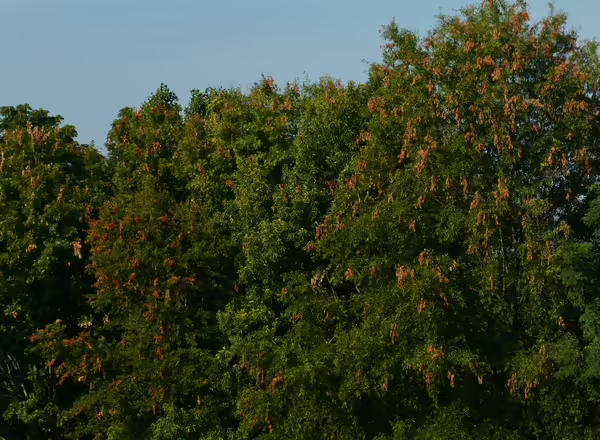
Can you hear them? Probably not yet, but soon, Illinois will be awash in the songs of periodical cicadas. This year (2024) is a big year for periodical cicadas in Illinois, where Broods XIII and XIX will be emerging throughout much of the state at the same time. This is the first time this has happened since 1803, and it won’t happen again until 2245! Despite some talk of an impending insect apocalypse, cicadas don’t pose a threat to humans (or pets), although that newly planted tree or shrub may be a different story.
While two broods will be emerging at the same time, they won't be emerging in the same places. Brood XIII, also known as the Northern Illinois Brood, will be emerging in the northern half of the state. Brood XIII contains all three species of 17-year periodical cicadas: Magicicada septendecim, M. cassini, and M. septendecula. In addition to Illinois, this brood will be emerging in Indiana, Iowa, Wisconsin, and possibly Michigan.
Brood XIX, also known as the Great Southern Brood, will be emerging in the southern half of Illinois. The four species of cicadas in this brood are 13-year cicadas: Magicicada tredecim, M. neotredecim, M. tredecassini, and M. tredecula. This brood is the largest of the 13-year broods, geographically speaking, and will emerge across Alabama, Arkansas, Georgia, Illinois, Indiana, Kentucky, Louisiana, Mississippi, Missouri, North Carolina, Oklahoma, South Carolina, Tennessee, and Virginia.
There may be a few places in central Illinois, around Springfield, where the two broods will be emerging in the same area. However, they aren’t expected to overlap to any great extent.
In addition to Broods XIII and XIX, there may be some cicadas from Brood XXIII, the Mississippi Valley Brood, that may emerge. This brood will emerge in 2028, but occasionally, some periodical cicadas will emerge four years early, which in this case would be 2024, and are referred to as stragglers. If any stragglers from Brood XXIII do emerge it will be primarily in far southern Illinois. Download the Cicada 2024 Broods Fact Sheet, which includes a map of where periodical cicadas are expected to emerge.
Periodical cicada life-cycle and biology
Periodical cicadas are among the longest-lived insects on the planet, living for 13 or 17 years. They spend the vast majority of that time living underground, feeding on tree roots. Once the soil warms enough in the spring (64°F at 8 inches deep), they will begin to emerge, depending on where you are located, sometime in May or early June. The nymphs usually emerge from the soil in the evening and will climb up trees or other objects and molt, leaving behind the familiar cicada ‘shells’ (shed exoskeleton).
After the adults emerge, they are white, soft, and squishy but will darken and harden overnight. Contrary to popular belief, adult periodical cicadas do feed on plants (usually woody plants). However, they will spend most of their time above ground reproducing.
Male cicadas will start singing four or five days after they emerge. They will gather in trees and sing together to attract females. Females lack structures to produce sound (tymbals), so only males will sing. Each species of cicada has a distinctive song they produce.
After mating, female periodical cicadas will lay their eggs in the new growth of woody plants. They prefer branches that are about the width of a pencil or a little larger (up to ½ inch or so in diameter). They will use their saw-like ovipositor (egg-laying organ) to cut into branches and lay 10-20 eggs before moving further down the branch. In total, each female will lay around 500-600 eggs.
After about a month, the adult cicadas will begin to die. Large piles of cicadas can accumulate under trees and can smell rather unpleasant (similar to roadkill). However, their decaying bodies will serve as fertilizer for plants.
Six to ten weeks after they are laid, the eggs will begin to hatch. The tiny cicada nymphs will drop to the ground and begin feeding, often on grass roots. Over time, they will dig down into the soil, 8-12 inches deep, and feed on tree roots for the next 13 or 17 years.




Are periodical cicadas going to kill my trees?
As female periodical cicadas lay their eggs, they will cut open branches with their ovipositor. This will result in a scar that can be several inches long. These damaged areas may sometimes break, which will cause everything past this damaged area to die. This is often referred to as flagging. Fortunately, this will not kill healthy, mature trees. The same can’t be said for small trees and shrubs, though.
Newly planted small trees and shrubs may have trunk diameters small enough for female cicadas to lay their eggs in; if this happens, the trees can be killed. These smaller plants also have fewer branches on them, and egg-laying can cause significant damage to the trees.
Protecting trees and shrubs from periodical cicada damage
There are several things you can do to prevent cicada damage to trees and shrubs in your landscape:
- Avoid planting trees and shrubs the year before a periodical cicada emergence. Avoid planting trees and shrubs in the spring of an emergence year, too. If you do need to plant, choose plants that have a stem diameter of at least 2½ inches in diameter.
- Place netting around small trees and shrubs (up to 10 feet tall), making sure it is secured around the base of the plant to prevent cicadas from crawling up the plant from the ground. The opening should be no larger than ¼ inch. It may be helpful to build a frame around the plants, cicadas may still be able to lay eggs on branches that are touching the netting.
- Twigs and branches that have had eggs laid in them can be pruned off to prevent the nymphs from reaching the ground and feeding. However, feeding by cicada nymphs does not seem to be harmful to the trees they feed on.
- Insecticides are not recommended to manage periodical cicadas in home landscapes. Large, healthy trees are able to survive egg-laying with no long-term impacts (this has been happening for thousands of years). Insecticides are not as effective in protecting smaller trees and shrubs from cicadas as netting. Additionally, applying pesticides to control cicadas may harm other organisms, including animals that eat cicadas.
- Cicada killer wasps won’t be of any help either. They emerge later in the year when annual or dogday cicadas emerge, and by that time, periodical cicada adults will be dead.
How are periodical cicadas different than the cicadas we see every year?
Annual or dogday cicadas appear every summer (July - September) in Illinois. This isn’t because they only live for one year; it typically takes 2 to 5 years to complete their development. but because they have overlapping generations and are not synchronized. Periodical cicadas, on the other hand, take 13 or 17 years to complete their development from egg to adult, and they emerge in mass in the spring.
They also look different. Annual cicadas are about 1½ to 2½ inches long and have a green and brown pattern to green and black pattern with a mostly white underside. Periodical cicadas are smaller, around ¾ to 1½ inches long. They have black bodies with orange wing veins and red eyes.
What is a cicada brood?
A cicada brood is simply a group of periodical cicadas that emerge in a given year (there can be multiple species). There are 12 broods of cicadas with 17-year life cycles and three broods with 13-year life cycles. Each brood is assigned a Roman numeral. For example, Brood XIII is a group of periodical cicadas that emerge every 17 years (1973, 1990, 2007,2024, 2041, etc.), and Brood XIX is a group of cicadas that emerge every 13 years (1985, 1998, 2011, 2024, 2037, etc.).
Why do periodical cicadas come out in huge numbers every 13 or 17 years?
One theory as to why periodical cicadas emerge in 13- or 17-year intervals is because those are prime numbers (can only be divided by one and themselves). This makes it difficult for predators to evolve life cycles that would sync up with the cicadas.
It is believed that one reason periodical cicadas emerge in mass is to overwhelm predators. In 1956, entomologists at the Field Museum in Chicago estimated that as many as one million cicadas emerged per acre in a forested floodplain near Chicago, and over 130,000 emerged per acre in an upland site. Predators may eat hundreds or thousands of cicadas, but there will still be thousands left uneaten that will be able to reproduce.
Another theory is that they developed this life cycle due to ice ages. The thought is that during this time, temperatures were colder, which slowed the growth of cicadas, which extended their life cycle (slower plant growth could also have contributed). Because of these longer life cycles, cicadas began to synchronize their emergence in order to find mates.
This year (2024) provides us with a once-in-a-multi-generation opportunity. Take some time to track down some cicadas and enjoy nature’s symphony.
Good Growing Fact of the Week: Depending on where you live and the number of cicadas around you, it may get loud. According to the National Institutes of Health, calls of male cicadas can reach over 90 decibels (dBA), which is as loud as a lawnmower, motorcycle, or tractor.
Bonus Fact of the Week: Wildlife aren’t the only things that can eat cicadas; you can too! If you want to try some, collect adults after they have molted but before they harden (while they are still white). If you are allergic to shellfish, you should avoid eating them, though.
Bonus Bonus Fact of the Week: This is the first time that Broods XIII and XIX will be emerging at the same time since 1803, and a lot has changed since then…
- Thomas Jefferson was President of the United States
- Fort Dearborn was constructed on the site that is now Chicago. (Chicago wasn’t incorporated until 1833 and didn’t become a city until 1837).
- The United States completed the Louisiana Purchase from France.
- The Napoleonic Wars began when the United Kingdom declared war on France.
- The 12th amendment is approved by Congress (it would be ratified in 1804)
- The elements rhodium, palladium, osmium, iridium, and cerium were discovered
Resources and more information
Cicada Mania
Cicada Safari
Cooley, John. 2017. “General Periodical Cicada Information | Cicadas.” Cicadas.uconn.edu. February 16, 2017. https://cicadas.uconn.edu.
Hepler, James R, W Rodney Cooper, John P Cullum, Chris Dardick, Liam Dardick, Laura J Nixon, Derek J Pouchnik, Michael J Raupp, Paula Shrewsbury, and Tracy C Leskey. 2023. “Do Adult Magicicada (Hemiptera: Cicadidae) Feed? Historical Perspectives and Evidence from Molecular Gut Content Analysis.” Journal of Insect Science 23 (5). https://doi.org/10.1093/jisesa/iead082.
Kritsky, Gene. 2024. A Tale of Two Broods: The 2024 Emergence of Periodical Cicada Broods XIII and XIX. Columbus, OH: Ohio Biological Survey.
Kirtsky, Gene. 2004. Periodical Cicadas the Plague and the Puzzle. Indiana Academy of Science.
Yoshimura, Jin. 1997. “The Evolutionary Origins of Periodical Cicadas during Ice Ages.” The American Naturalist 149 (1): 112–24. https://doi.org/10.1086/285981.
Photo Credits
Cicada emergence holes: "Cicada emergence holes" (CC BY 2.0) by rmuser
Newly emerged adult cicada: By G. Edward Johnson - Own work, CC BY 4.0, https://commons.wikimedia.org
Cicada 'skin': "Youth left behind" (CC BY-SA 2.0) by Andy Melton
Flagging trees:"Cicada Flags" (CC BY 2.0) by F Delventhal
Want to get notified when new Good Growing posts are available? SIGN ME UP!
Give us feedback! How helpful was this information (click one): Very helpful | Somewhat helpful | Not very helpful
MEET THE AUTHOR
Ken Johnson is a Horticulture Educator with University of Illinois Extension, serving Calhoun, Cass, Greene, Morgan, and Scott counties since 2013. Ken provides horticulture programming with an emphasis on fruit and vegetable production, pest management, and beneficial insects. Through his programming, he aims to increase backyard food production and foster a greater appreciation of insects.